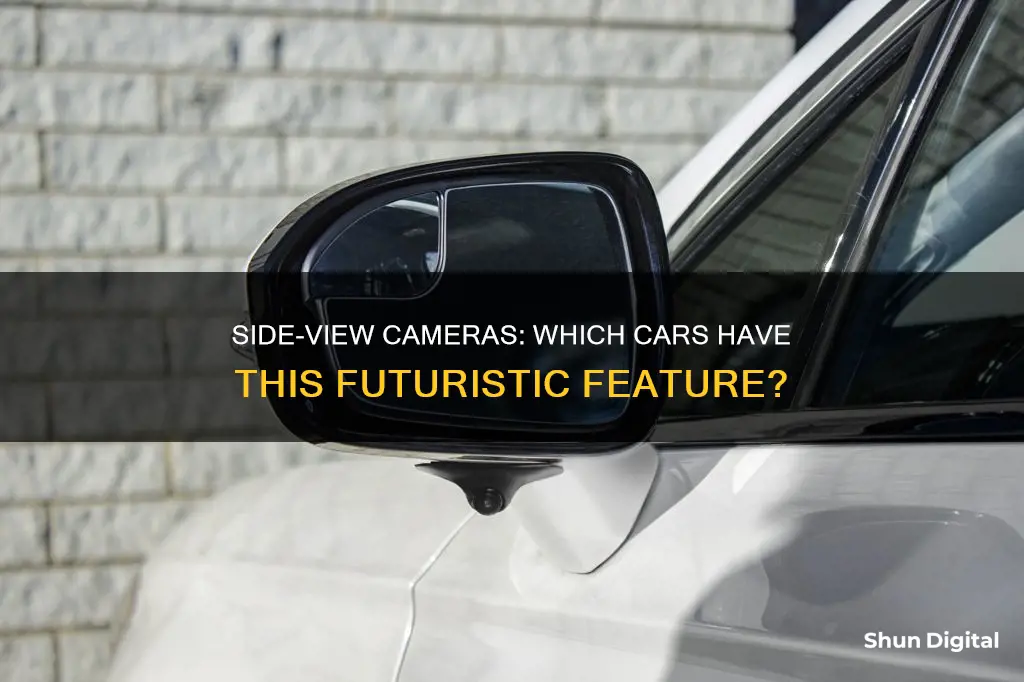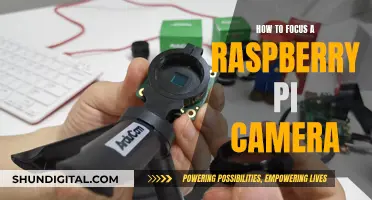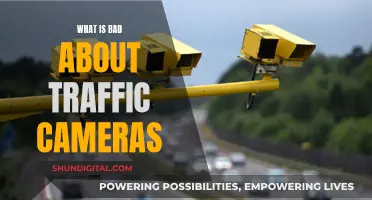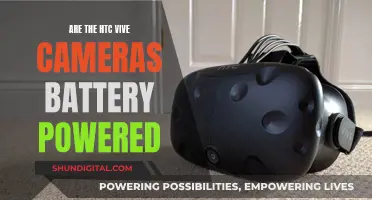
Side-view cameras are becoming an increasingly popular feature in modern cars. These cameras are usually part of a blind-spot monitoring system, which aims to improve safety by providing drivers with a live video feed of their blind spots. While some cars have basic blind-spot monitoring systems, such as a simple light or warning chime, side-view cameras offer a more comprehensive solution by displaying a live feed on the vehicle's infotainment screen or instrument cluster. This allows drivers to easily see any vehicles or obstacles that may be in their blind spot before changing lanes or making a turn.
Several car manufacturers have incorporated side-view cameras into their models, including Genesis, Honda, Hyundai, Kia, and Tesla. These cameras are often found in higher-end vehicles or as an option in the top trims of more affordable models. In addition to side-view cameras, some cars also offer other advanced safety features, such as lane-keeping assist, adaptive cruise control, and forward-collision warning systems.
It is worth noting that side-view cameras are usually offered as an additional feature and may not be standard on all vehicles. Therefore, when considering a car with side-view cameras, it is important to check the specific trim levels and options available.
What You'll Learn

Blind-spot cameras vs. blind-spot monitors
Blind-spot cameras and monitors are both safety features designed to assist drivers in detecting and avoiding potential hazards in their blind spots. However, they differ in terms of functionality, effectiveness, and impact on the driving experience.
Blind-spot monitors, also known as blind-spot detection systems, typically use sensors such as radar, ultrasonic sensors, or cameras to detect objects in the vehicle's blind spots. These systems provide an alert or warning to the driver when a vehicle is approaching or present in the blind spot, usually in the form of a visual or audible notification. While these systems are effective in reducing accidents and increasing driving awareness, they may not provide a direct view of the blind spot area.
On the other hand, blind-spot cameras offer a more direct solution by providing a live feed or image of the blind spot area. This allows drivers to have a clear view of any potential hazards without relying solely on sensors or notifications. Blind-spot cameras are often integrated into the side mirrors or displayed on a central screen, giving drivers a more comprehensive understanding of their surroundings.
One example of a blind-spot camera system is the Rostra dual-camera blind-spot vision system, which includes low-profile CMOS colour cameras that can be installed neatly under the vehicle's side-view mirrors. These cameras provide drivers with an improved view of obstructed areas, enhancing their confidence when changing lanes.
While blind-spot monitors are more widely available and can be found as standard or optional features in many modern vehicles, blind-spot cameras are less common. Honda, for instance, previously offered its LaneWatch system, which displayed the passenger-side blind spot on the centre screen when the turn signal was activated. However, they have since moved away from this camera system in favour of a more traditional blind-spot monitor.
In conclusion, both blind-spot cameras and monitors serve the same purpose of enhancing driver awareness and preventing accidents. Blind-spot monitors are more prevalent and provide alerts to notify drivers of potential hazards, while blind-spot cameras offer a direct visual of the blind spot area. The choice between the two ultimately depends on personal preference, vehicle compatibility, and the level of assistance desired by the driver.
Surveillance in Courtrooms: Are Cameras Allowed?
You may want to see also

Side cameras in luxury vehicles
Side cameras are becoming an increasingly popular feature in luxury vehicles, offering drivers improved safety and visibility when changing lanes or parking. While some cars have simple blind spot monitors that illuminate a light or make a warning chime, side cameras provide a live video feed of what's in your blind spot, giving you a much clearer view of your surroundings.
Several luxury vehicles now offer side cameras as an optional extra or as a standard feature. For example, the Genesis G70, G80, and G90 all include a blind-spot view monitor (BVM) that shows a live feed from a side-view mirror camera on the car's dashboard or instrument cluster. Similarly, the 2022 Hyundai Sonata Limited and the Kia Stinger GT2 offer a BVM that displays a live feed when the turn signal is activated.
Other luxury car manufacturers, such as Buick, Infiniti, and Lexus, have also started to include side cameras in their vehicles. The 2025 Buick Enclave, for instance, comes with a 30-inch touchscreen and hands-free driving capabilities. The Infiniti QX80 features a 3.5L V6 Turbo engine, four-wheel drive, and a range of modern features and tech improvements. Lexus has also introduced the TX, a three-row SUV with a choice of three powertrains, including a hybrid and plug-in hybrid option.
While side cameras are currently more common in luxury vehicles, we may see them becoming more widely available in the future as new cars are introduced and the technology becomes more refined.
Avoid School Bus Camera Tickets: Tips to Save You Money
You may want to see also

Side camera installation
Side-view cameras, also known as blind-spot cameras, are becoming an increasingly popular feature in modern cars. These cameras provide a live feed of the blind spot, which is displayed on the infotainment screen or instrument cluster, offering a significant advantage over traditional side mirrors. While some car manufacturers offer this feature directly, others require you to install it as an aftermarket upgrade. Here is a step-by-step guide on how to install side-view cameras:
Step 1: Gather the Required Parts
Before starting the installation process, ensure you have all the necessary parts, including cameras, a display unit (such as a dashboard screen or a replacement rear-view mirror), wiring harnesses, and any other required accessories. You can purchase these items individually or as a kit.
Step 2: Mount the Cameras
Decide on the placement of the cameras. They should be positioned to capture the blind spot effectively. Carefully drill holes in the desired locations, taking into account the angle and height of the cameras. Securely mount the cameras, ensuring they are firmly attached to the vehicle.
Step 3: Run the Wiring
This step involves snaking wires from the cameras to the display unit and power source. Carefully route the wires through the interior of the vehicle, concealing them as neatly as possible. You may need to remove some interior panels to access the necessary areas. Connect the camera wires to the display unit and power source, following the instructions provided with your equipment.
Step 4: Connect to a Power Source
The cameras will require a power source to function. You can splice into an existing power circuit, such as the fuse box, or use a 12-volt outlet, depending on your preference and the specific equipment you are using. Ensure that the connection is secure and will not cause any electrical issues.
Step 5: Test the System
Once the cameras and display are connected, test the system to ensure it is functioning correctly. Adjust the camera angles as needed to get the desired field of view. Test the system in different lighting conditions, including at night, to ensure the cameras provide a clear view.
Step 6: Fine-Tune the Settings
Depending on your specific setup, you may have various settings to adjust, such as guidelines, brightness, and other features. Fine-tune these settings to your preference and ensure you are comfortable with how the system operates.
Step 7: Finalize the Installation
Once you are satisfied with the performance and settings of your new side-view camera system, finalize the installation by securing any loose wires and reinstalling any interior panels you had to remove. Ensure that all connections are secure and that the cameras and display are firmly mounted.
By following these steps, you can successfully install side-view cameras on your vehicle, enhancing your visibility and improving safety. Remember to consult a professional if you have any doubts or concerns during the installation process.
Privacy Mode on D-Link Cameras: What You Need to Know
You may want to see also

Side camera features
Side-view cameras are a great feature for cars, providing a live feed of your blind spot on either your infotainment screen or instrument cluster. This feature is distinct from blind-spot monitors, which may simply be a warning light or chime. With a side-view camera, you get a live video feed of what you're not seeing, increasing your safety and awareness while driving.
Some cars that offer side-view cameras include the Genesis G70, G80, and G90, which all provide a live feed of the blind spot when the turn signal is activated. The Honda Clarity Plug-in Hybrid and Fuel Cell models also offer a similar feature, displaying a live feed on the infotainment screen when the right turn signal is used.
The Hyundai Sonata Limited and Kia Stinger GT2 also include side-view cameras as standard or optional features, providing a live feed to assist with lane changes and merging.
Additionally, there are aftermarket side-view camera systems available, which can be installed on your car's side mirrors or door sides. These cameras provide a wide-angle view of your blind spot, increasing visibility and safety.
Hacking Risks: Webcam Security and Privacy Concerns
You may want to see also

Side camera alternatives
Side-view cameras, also known as blind-spot cameras, are becoming an increasingly popular feature in modern cars. These cameras provide a live feed of the blind spot, which is displayed on the infotainment screen or the instrument cluster. This feature enhances safety by offering drivers a clear view of their surroundings when changing lanes or parking.
While side-view cameras are typically found on luxury vehicles or higher trim levels of more affordable cars, there are alternative options available for those who want to add this feature to their existing vehicle. Aftermarket side-view cameras can be purchased and installed on a car, providing a cost-effective solution for those who want the benefits of this technology without having to purchase a new car.
One example of an aftermarket side-view camera is the Master Tailgaters Side Cameras, which offer a right and left-side camera that can be installed on the car's side mirrors. These cameras provide a clear view of the blind spot and can be easily integrated into the vehicle's existing display system.
Another option is the PRUVEEO 360-degree view dash cam, which offers four channels of video footage, including front, rear, and side views. This system provides a comprehensive view of the vehicle's surroundings, enhancing safety and making it easier to navigate tight spaces. The dash cam also includes built-in GPS, Wi-Fi, and night vision, making it a feature-rich alternative to traditional side-view cameras.
For those who want a more discrete solution, there are side-view cameras that can be mounted on the car's body, such as the PARKVISION Mini Car Side View Camera. This camera has a rotatable lens and can be installed without drilling, making it a convenient and damage-free option.
In addition to aftermarket solutions, some car manufacturers are also offering side-view cameras as optional add-ons for their vehicles. For example, Nissan offers its Intelligent Around View Monitor as an optional feature on select models, providing a 360-degree view of the vehicle's surroundings. This trend towards democratizing advanced safety features is making side-view cameras more accessible to a wider range of drivers.
Calibrating Your Car Camera: A Step-by-Step Guide
You may want to see also
Frequently asked questions
While both systems warn the driver of obstacles in their blind spot, they do not do so in the same way. A blind spot monitor may be a simple light that illuminates on the side mirror or inside the vehicle, or a warning chime. A blind spot camera, on the other hand, provides a live video feed of the blind spot, giving the driver a much clearer idea of their surroundings.
Blind spot cameras are available on the following models:
- 2021 Honda Clarity Plug-in Hybrid
- 2021 Honda Clarity Fuel Cell
- 2022 Hyundai Sonata Limited
- 2022 Kia Stinger GT2
- Genesis G70, G80, and G90
Blind spot cameras improve safety by providing drivers with a live video feed of their blind spots, allowing them to make more informed decisions when changing lanes or merging. This can be especially useful in vehicles with large blind spots, such as SUVs or trucks.
A blind spot camera is typically activated when the driver uses the turn signal. The live feed from the camera is displayed on the vehicle's infotainment screen or instrument cluster, giving the driver a clear view of any obstacles that may be in their blind spot.
Yes, some vehicles offer blind spot monitoring systems that use sensors to detect obstacles in the blind spot and provide a warning to the driver. These systems may include a simple light or chime, or more advanced features such as steering assistance to help avoid a potential collision.







